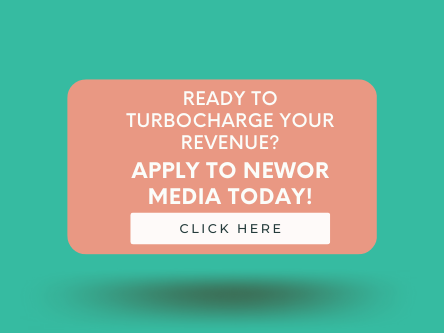
Video ads are dynamic video clips that marketers use to promote products or services to a target audience. These ads often appear before, during, or after streaming content online and across various digital platforms like social media and websites.
Businesses leverage video ads to capture attention quickly, convey their messages effectively, and engage viewers on a deeper level than traditional static advertisements allow.
Video ads have a profound impact on user engagement and revenue potential. Video ads can stir emotions and drive action by providing a rich, immersive experience that combines visuals, sound, and movement. They hold the viewer’s attention longer, leading to improved recall of the advertised product or service.
This, in turn, can significantly increase the likelihood of converting views into sales, thereby enhancing business revenue streams. As consumers increasingly gravitate towards video content, the role of video ads in a marketing strategy is becoming more crucial than ever.
The Impact of Video Ads
Video ads are a transformative digital marketing tool, offering unparalleled potential to engage audiences and drive revenue growth. By leveraging the power of visual storytelling, these ads captivate viewers and foster a deeper connection with brands.
How Can Video Ads Boost User Engagement?
Video ads excel at engaging audiences through compelling storytelling and visual appeal. By incorporating motion and sound, these ads grab attention more effectively than static images or text. They immerse viewers in a narrative, fostering emotional connections and making the message memorable.
Companies utilize interactive elements like clickable links, quizzes, and calls to action within video ads to encourage viewers to interact directly with the content, significantly increasing engagement levels.
Moreover, well-crafted video ads can keep viewers on your platform longer, which signals to search engines and social platforms that your content is valuable, potentially boosting your visibility and reach.
How Video Ads Impact Revenue
Incorporating video ads into your marketing strategy can substantially increase revenue potential. They provide a dynamic way to demonstrate product features, benefits, and usability, which helps reduce doubts and answer consumer questions effectively.
Video ads can also target specific audiences with personalized content, increasing the ad’s relevance to each viewer and enhancing the likelihood of purchase.
With advanced tracking and analytics, marketers can fine-tune their strategies to maximize return on investment. Businesses often see a higher return on ad spend with video ads than other formats due to their effectiveness in driving direct sales and long-term brand loyalty.
Types of Video Ads
Exploring various formats of video ads allows marketers to select the most effective approach based on their specific goals and target audience. Each format offers unique benefits and challenges that can significantly influence the campaign’s success.
Understanding these formats and their impacts enables marketers to tailor their strategies to meet their objectives better, whether aiming to maximize reach, engagement, or interactive experiences.
Several key formats dominate the video advertising landscape:
- In-Stream Video Ads: These play before, during, or after other videos on platforms like YouTube or social media feeds. They can be skippable after a few seconds or non-skippable.
- Out-Stream Video Ads: These ads might appear in text content or as website banners if found outside of videos. They start playing automatically, usually without sound, aiming to attract viewer attention as they scroll.
- Interactive Video Ads: These include elements that viewers can click on, leading to further engagement opportunities. They might prompt viewers to visit a website, watch another video, or view a product catalog.
- 360-Degree Video Ads: Offering a panoramic view, these ads allow viewers to control their perspective, giving them a more immersive experience.
- Live Video Ads: Incorporated into live streaming content, these ads harness the popularity of real-time broadcasting on platforms like Twitch or Facebook Live.
How To Design Effective Video Ads
Crafting effective video ads involves more than just capturing footage and adding music. It demands a strategic approach to ensure the content resonates with the target audience and drives them to action.
Here are critical steps to follow when designing compelling video ads:
Identify Your Audience
Start by pinpointing precisely who you want to reach with your video ad. Understand their preferences, behaviors, and pain points. Tailored content that speaks directly to the audience’s interests and needs will always perform better than generic messaging.
Develop a Clear Message
What is the core message you want to convey? Keep it concise and focused. A clear, straightforward message ensures your audience understands your ad’s intent without confusion. Each video should have one main takeaway that is easy to remember.
Create Engaging Visuals and Audio
Use high-quality visuals and clear, crisp audio to make your video ad stand out. Incorporate vibrant images, legible text, and professional-grade sound to ensure your message is seen and heard clearly. Visuals should align with your brand and message, enhancing the overall storytelling.
Include a Strong Call-to-Action
What do you want viewers to do after watching your video? Whether visiting a website, signing up for a newsletter, or purchasing, your call-to-action (CTA) should be evident and compelling. Place your CTA prominently and repeat it to reinforce the message.
Optimize for Different Platforms
Each social platform has its own specifications and audience behavior. Customize your video ads for the platforms where they will run. For example, shorter videos work better on Instagram, while longer, more detailed videos can be effective on YouTube.
Video Ads vs. Other Ad Formats
Understanding the differences between video ads and other ad formats, such as display ads, can help marketers decide where to invest their advertising budget.
Incorporating video ads into your marketing strategy can enhance engagement, improve conversion rates, and provide a substantial return on investment compared to other ad formats.
What’s the Difference Between Video Ads and Display Ads?
Video ads are dynamic, incorporating motion and sound to tell a story or highlight a product. They engage viewers through visual elements, dialogue, music, and sometimes interactive features.
Video ads are often hosted on platforms supporting video content, such as YouTube, social media sites, or streaming services.
Display ads, in contrast, are static images or graphics that appear on websites, apps, or social media feeds. They include text, photos, and sometimes animation but do not offer the same interaction or narrative level as video ads. Display ads are typically used to build brand awareness or retarget visitors with a banner or side-page advertisements.
Why Might Video Ads Be More Effective Than Other Formats?
Video ads can be more effective than other formats for several reasons:
- Higher Engagement: Video ads tend to hold viewer attention longer than static ads, leading to better engagement rates. The dynamic nature of video can evoke emotional responses, making the message more memorable.
- Better Storytelling: Video provides a multi-sensory experience better suited for storytelling. Brands can use video to create a narrative around their products or services, helping to build a connection with the audience.
- Impact on Conversions: Videos can demonstrate product functionality or showcase benefits more effectively than images, driving higher conversion rates. Viewers are likelier to purchase a product after watching a related video ad.
- Optimized for Mobile: With increasing numbers of consumers accessing content on mobile devices, video ads are a smart choice because they play well on small screens and can be optimized for mobile viewing.
- Versatility Across Platforms: Video ads can be adapted and used across multiple platforms, including social media, websites, and mobile apps, providing a consistent message across all touchpoints.
Best Practices for Video Ad Campaigns
Creating compelling video ad campaigns involves more than producing good content; it also requires strategic planning and continuous optimization. Here, we explore how to optimize video ads for maximum engagement and the key strategies that enhance their overall effectiveness.
Following these best practices, you can optimize your video ad campaigns to maximize engagement and enhance effectiveness, driving better results and achieving your marketing goals.
Optimizing video ads for engagement starts with targeting the right audience. Use data-driven insights to understand who your viewers are and what they prefer. Here are practical steps to ensure your video ads engage your target audience effectively:
- Test Different Versions: Use A/B testing to try different versions of your ad. Analyze which elements resonate best: a particular phrase, image, or tone.
- Optimize for Mobile: Ensure your video ads are formatted correctly for mobile devices. Most users consume video content on their phones, so your ads must look good on smaller screens.
- Use Captivating Thumbnails and Titles: Attract viewers with eye-catching thumbnails and compelling titles that promise valuable content. These elements can significantly influence click-through rates.
- Incorporate Captions: Many users watch videos without sound, especially on mobile. Including captions ensures your message gets across even when the audio is off.
Key Strategies to Enhance Video Ad Effectiveness
To enhance the effectiveness of your video ads, consider these strategies:
- Focus on the First Few Seconds: Capture attention quickly. The initial moments of your video determine whether viewers keep watching, so start strong with a compelling hook.
- Include a Clear Call-to-Action: Make it easy for viewers to know what to do next. Whether visiting a website, signing up for a newsletter, or watching another video, your CTA should be clear and compelling.
- Leverage Storytelling: People remember stories better than facts alone. Use storytelling to make your message memorable and engaging.
- Measure and Adjust: Continuously track the performance of your video ads. Use analytics to measure key metrics like view, engagement, and conversion rates. Adjust your strategies based on what the data tells you.
Future of Video Ads
As we look forward, several trends and technological advancements are set to redefine the landscape of video advertising. Understanding these changes will help marketers stay ahead in a competitive field.
Trends Shaping the Future of Video Advertising
Interactive video content is gaining traction, offering viewers a more engaging experience. This trend allows viewers to interact with the video content, make decisions, play games, or shop directly from the ad.
Virtual reality (VR) and augmented reality (AR) are also emerging as powerful tools for creating immersive ad experiences that allow brands to connect with their audience innovatively.
Personalization is another significant trend. Data analytics and artificial intelligence (AI) advances enable marketers to create highly targeted ads tailored to individual preferences, increasing relevance and effectiveness.
Moreover, programmatic video advertising is becoming more sophisticated, allowing real-time bidding on ad inventory matching precise audience profiles.
How Is Technology Enhancing Video Ad Capabilities?
Technology is pivotal in enhancing video ad capabilities making ads more effective and engaging. AI is at the forefront, optimizing ad content for search engines and improving user targeting through better data analysis.
Machine learning algorithms can predict viewer preferences and behaviors, allowing for the automatic adjustment of ad content to suit individual viewers.
Blockchain technology is beginning to impact video advertising by increasing transparency in ad deliveries, ensuring that advertisers pay only for genuine engagements.
5G technology is also expected to drastically improve video streaming quality and expand the potential for high-definition mobile video ads without buffering issues.
These technological advancements are making video ads more interactive, personalized, and efficient, thereby enhancing the ability of marketers to reach audiences with compelling content that drives engagement and revenue.
As these technologies evolve, they will undoubtedly open new avenues for creativity and connection in video advertising.
The Power of Video Ads in Modern Marketing
Investing in video ads is crucial for businesses today because it aligns with how consumers prefer to receive information and make purchasing decisions. Video content offers dynamic and compelling ways to showcase products and services, making it an indispensable tool in a marketer’s arsenal.
Video ads drive engagement and conversion rates higher than any other advertising format. They allow brands to tell their story engagingly, fostering deeper connections with the audience.
As digital landscapes evolve and consumer attention spans shorten, video ads quickly and effectively communicate key messages and persuade potential customers.
Moreover, with the increasing accessibility of video production tools and platforms, video ads offer a cost-effective solution for businesses of all sizes seeking to boost their market presence and sales.

